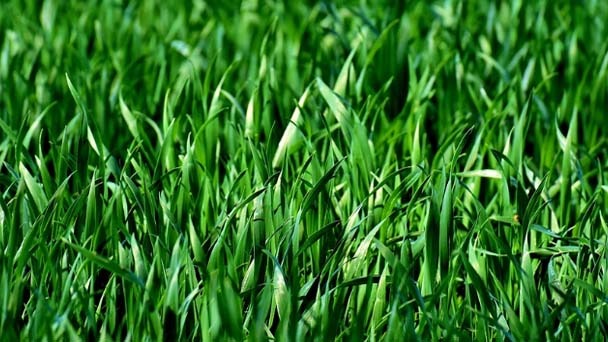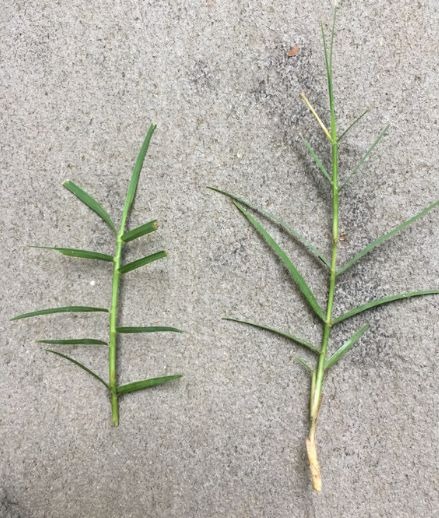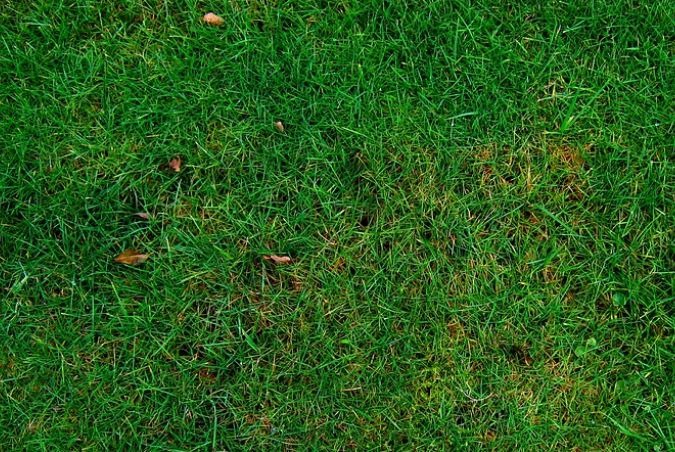Centipede Grass vs. Bermuda - Differences & How to Choose
Written by Ivy
Jan 10 2023

Depending on how quickly you want your lawn to grow, you should choose between Bermuda grass and centipede grass. They are both tough grasses that can withstand the harsh weather and southern sunshine. While Bermuda grows quickly and will eventually suffocate Centipede grass if left unchecked, Centipede grass grows slowly.
What is Centipede Grass
Centipedegrass (Eremochloa ophiiuriides) is a slow-growing warm-season grass with a short upright stem that resembles a centipede. This grass is indigenous to China and southern Asia. Greens, lawns, and parks frequently contain centipedegrass.
This grass spreads from stolons that creep. It has coarsely textured, 15–30 mm long, yellow–green leaf blades. The leaves can have pointed tips at the tips and can be flat, rounded, or lanceolate at the base. Racemes of purple spikelets make up the inflorescence.
Centipedegrass grows from seeds, sods, and sprigs.
Sandy, acidic soil with a pH of 5.0 to 6.0 is ideal for centipedegrass. Its ideal soil composition has a high potassium and iron content but a low phosphorus content. If the soil is low in iron, the leaves will turn yellow.

If soil tests show that the soil pH is higher than 7.2, add sulfur; if the pH is lower than 5.0, add lime. In full sun, this grows well. Although it would still thrive in some shade, six hours of direct sunlight would bring out its best qualities.
Due to its low mowing, watering, and fertilizer requirements, centipedegrass is frequently referred to as the "lazy man's grass." Abrasions or heavy foot traffic, however, do not cause it to quickly recover. If cutting through stressed grass, set the mower to 1-1 ½ inches.
More than 40 inches of rain must fall each year to support centipedegrass. To avoid wintertime desiccation, the grass should receive 4 to 6 inches of deep watering. If the grass becomes stressed during the summer and loses its color and leaves, water it deeply to aid in its recovery. If not, water it with an inch of water every week while it is growing.
Applying nitrogen fertilizer to centipedegrass is not necessary at all. Apply less than 2 pounds of nitrogen fertilizer per 1000 square feet of lawn each spring and fall, if necessary. If too much fertilizer is used, thatch will develop.
Centipedegrass develops a weed vulnerability in its early stages. After establishing, it does, however, moderately resist them. Centipedegrass lawns frequently host insects like ground pearl, mole crickets, spittlebugs, and white grubs. Additionally widespread are large patches and spot diseases. Due to its poor tolerance to cold, centipedegrass is harmed by winter weather in conditions where there is snow. It can be harmed by hard frost and even perish.
What is Bermuda Grass
Bermuda grass is a perennial grass that quickly spreads and forms sods. It is native to Africa but is common throughout tropical and subtropical areas. Common bermudagrass ( Dactylon cynodon) is the most pervasive species.
Tennis courts, golf courses, parks, and lawns frequently feature Bermudagrass. Both turf and forage can be made from this grass. In contrast, northern lawns are thought to have an invasive weed. Bermudagrass spreads via rhizomes, seeds, and stolons after establishing itself in sods, plugs, and seeds.
This grass produces a dense turf with dark green leaf blades that are hairy or only sparsely hairy. Its ligule is covered in white hairs, and the seedhead produces finger-shaped spikelets with three to six spikes. Bermudagrass has quick-spreading above-ground runners (stolons) that help it cover more ground.
Bermudagrass does well in fertile, well-drained soils with a pH range of 6.5 to 8.0. Add lime to raise pH levels when they are lower. The optimum soil temperature for this grass is 80oF.
Bermudagrass can't survive in shade; it needs direct sunlight to grow. When injured, it quickly recovers and can withstand high foot traffic. It is the most drought tolerant warm-season grass due to its deep, fibrous roots, which can withstand scorching, dry conditions.
25 to 100 inches of water per year are required for Bermudagrass. If the rainfall is less than 20 inches, irrigation can be added to make up the difference. The turf being used and environmental factors like temperature, light intensity, humidity, and winds all affect how much watering is required. More watering is required where these conditions are severe. In high maintenance areas, such as golf courses, the grass needs to receive 0.1 to 0.3 inches of water daily, depending on the climate.
The variety and level of maintenance affect the mowing height and frequency. Bermuda grass requires frequent mowing and requires a lot of maintenance. When the grass is actively growing, it is trimmed when it reaches a height of 3 to 4 inches.
A lot of fertilizer is needed for Bermudagrass. On Bermudagrass lawns that require a lot of maintenance, you need 1 to 1.5 pounds of nitrogen per 1000 square feet, and you only need 0.5 pounds per 1000 square feet.
Nematodes, dead spots, brown patches, dollar spots, and leaf spots are all typical diseases of Bermudagrass. Where Bermuda is the preferred turf, invasive weeds like henbit, clovers, and chickweed are prevalent.
Bermuda Vs. Centipede Grass
Excellent grasses for southern lawns include Bermudagrass and centipedegrass. They do, however, have unique leaf structures, a tolerance for lawn issues, appearance, etc. Let's examine these variations closely.
The distinctions between bermudagrass and centipedegrass are listed in the following summary table.
| Centipedegrass | Bermudagrass |
| Yellow-green, broad, coarse-textured leaves | Dark green, thin, fine-textured leaves |
| Shallow root system | Deep root system |
| Spreads by stolons | Spreads by stolons, rhizomes, and seeds |
| Low maintenance | Higher maintenance |
| Tolerates moderate traffic | Tolerates heavy traffic |
| Tolerates partial shade | Doesn't tolerate shade |
| The optimum soil temperature is 70oF | The optimum soil temperature is 80oF |
| Less durable | More durable |
| Vulnerable to weeds when young | Resistant to weeds when young |
The Origin
Tropical and subtropical regions all over the world are home to native populations of Bermuda grass. It is widespread in some regions of Africa, Europe, and Asia.
On the other hand, centipede grass is indigenous to China and Southeast Asia.
The Leaf Morphology
Centipedegrass has broad, yellow-green, coarsely textured leaves, whereas Bermudagrass has dark green, dense, and fine-textured leaves. Bermuda grass produces dense, fine-textured, dark-green leaf blades that, when grown on a lawn, have the appearance of a carpet. Centipede leaf blades contrast with being light green, wider, and thinner than bermudagrass.

The Root Structure
The roots of Bermudagrass are deep, whereas the roots of centipedegrass are shallow. Due to its shallow roots, centipede grass has a hard time surviving in arid environments with a meager water supply and low water tables.
Bermudagrass, on the other hand, has thick, fibrous roots that reach deep into the soil and draw water from the water table during the summer when it is dry. The grass is now the most resilient warm-season grass to drought.
Cultivators / How They Spread
Bermudagrass spreads via seeds, rhizomes, and stolons, whereas centipedegrass does so via stolons. A creeping stolon on a centipede allows it to spread by producing new roots and shoots.
Bermuda's rhizomes, on the other hand, reach deep into the ground to help it grow. From the parent plant, the runners or stolons are located laterally close to the ground. In order to create daughter plants, new shoots and roots grow at their nodes. Additionally, in a favorable environment, common bermudagrass seedheads disperse and sprout.
The Maintenance Requirements
Bermuda requires little attention, whereas centipede grass requires little. Centipedegrass doesn't require regular mowing because of its slow growth. In order to save money, time, and effort, it can survive with little to no fertilizer application. It also doesn't need to be watered every day.
Bermudagrass, on the other hand, needs a lot of upkeep. The turf requires mowing after 5-7 days due to its rapid growth and spread. When it is actively growing, it also requires heavy fertilizer application. To flourish, it requires daily watering.
Foot Traffic Tolerance
Bermuda can withstand heavy foot traffic, but centipedegrass can only handle moderate foot traffic. Only light or moderate foot traffic is acceptable on a centipede lawn. In areas with high foot traffic, it easily wears out. It couldn't endure on a sporting field.
A busy area would need to have Bermudagrass lining it. It is easily able to withstand the force of a sporting pitch.
Growing Requirements
Bermuda grass can withstand extreme heat and dry conditions. It can also thrive in almost any soil type as long as it receives direct sunlight. In Zones 6 through 10, it is a perennial, but in warmer climates, it will grow all year.
This particular species of grass requires a lot of nutrients and requires a lot of maintenance. Direct seed sowing is one method of propagation. Just be willing to put some effort into caring for it.
Centipede grass, on the other hand, is particular about the kind of soil it grows in. It can withstand heat but not drought, so it needs to be watered frequently. Furthermore, it cannot endure in soil that is too acidic. As a result, its growing areas are constrained.
Centipede grass, on the other hand, can tolerate some shade and requires a lot less nutrition.
Shade Tolerance
Even though centipedegrass requires full sun to survive, it can still grow and flourish in a partially shaded environment. Bermudagrass, on the other hand, needs full sun to survive. It is susceptible to early plant death when grown in the shade.
Optimum Temperatures
Centipedegrass thrives when the soil temperature is 70oIt's the ideal temperature for overseeding grass seeds at F. Meanwhile, Bermuda needs a soil temperature of 80oF to grow vigorously to create a thick and lush lawn.
The Durability
Bermudagrass is more resilient than centipedegrass, which is less resilient. If centipedegrass is exposed to heavy foot traffic or has an excessive amount of moisture, it can quickly become worn out. It serves primarily as decorative grass in low-traffic areas because it is easily broken.
Bermudagrass, on the other hand, is hardy and does not deteriorate under heavy foot traffic. It is more resilient and recovers quickly from foot traffic.
Weeds Invasion
When young, centipedegrass is more susceptible to weeds than Bermudagrass. Due to centipedegrass' slow growth and slow establishment in the lawn, weeds are able to spread and establish themselves more quickly.
Bermudagrass outcompetes weeds because it grows more quickly and vigorously to cover bare areas.
Pros of Centipedegrass
- Needs less maintenance
- Tolerates shade
Cons of Centipedegrass
- Grows slowly
- Wears on high traffic lawns
- Prone to insect infestation
Pros of Bermudagrass
- Establishes quickly and spreads fast
- Tolerates drought
- Withstands high foot traffic
Cons of Bermudagrass
- It can be an invasive weed
- Doesn't tolerate shade
- Poor cold tolerance
Is Bermuda Or Centipede Better?
Although both centipede and Bermuda are top-notch turfs, your decision will be influenced by your preferences for appearance, upkeep requirements, and grass durability.
If you want a thicker, more enticing lawn that is dark green, Bermudagrass is the better choice. However, a centipede lawn would be a great option if you want a yard that requires less time, money, and effort to maintain.
Kids, dogs, and people who frequently use the lawn and put a lot of traffic on it can all play on Bermudagrass. Additionally, the grass will last longer for you.

Can I Mix Bermuda and Centipede Grass?
On the same lawn, you cannot combine centipedegrass and Bermudagrass. Bermuda grass, however, can take the place of a centipede lawn.
These grasses require various amounts of water, fertilizer, and mowing. Centipede doesn't require the same types of maintenance procedures as Bermuda, which may require frequent mowing, fertilization, or watering. They do not mix well, which is bad for the grass's general health.
How Do I Know If I Have Centipede Or Bermuda Grass?
If your grass is dense, the leaf blades are thin and dark green, and it has invasive runners, Bermudagrass might be the cause. A low growth rate should also be checked.
However, centipedegrass may be present if the grass is light green, the leaves are broad, and they are arranged in opposition to one another in the stem.
Is Bermuda Grass Like Centipede Grass?
Although they have many differences, bermudagrass and centipedegrass have some characteristics in common. Both don't tolerate cold and go dormant when temperatures drop below 30oWinter injury affects F. centipedegrass. Bermudagrass and centipedegrass also have stolons or runners.
Conclusion
Although both centipede and Bermuda grass are warm-season grasses, their susceptibilities to heat, drought, traffic, cold, and shade vary. Bermuda grass grows quickly, so you might have to mow it more often than centipede grass, which needs less maintenance and thrives in sandy soil.
FAQs (Frequently Asked Questions)
Is Bermuda Grass a Good Grass to Have?
The resilience of Bermuda grass is outstanding. It is resistant to extreme heat and even dry conditions. It also withstands repeated use well.
What Are the Disadvantages of Bermuda Grass?
Maladies and pests can affect Bermuda grass. The fact that this grass species grows quickly, however, may be more crucial. If your lawn is next to a garden or flower bed, Bermuda grass will gladly take over the area.
What Are the Pros and Cons of Centipede Grass?
This type of grass grows slowly and at a low rate. It won't encroach on your lovely flowerbed, so you won't have to be concerned about that. It cannot stand the cold well, unfortunately. So you might have to choose a different species if you live in colder climates.
Which is Better, Bermuda Grass Or Centipede Grass?
How much depends entirely on the area where you plan to plant it or lay sod. In contrast to centipede grass, which holds up best under light use, Bermuda grass can withstand heavy use.
Latest Updated
- Benefits of Bugleweed - 7 Science-backed Health Benefits
- Bugleweed Dangers & Side Effects - Is It Poisonous?
- How to Plant Evergreen Trees - What You Should Know
- When to Plant Evergreens - Grow Guide for Evergreen Trees
- 12 Wonderful Evergreen Shrubs for Your Garden
- 12 Popular Evergreen Plants with Pictures for Beginners
- When And How To Prune A Lilac Bush Like a Pro
- How to Grow & Care for Lilac Vine (Hardenbergia Violacea)
- Japanese Lilac Tree (Syringa Reticulata) Care & Propagation Guide
- Shumard Oak Pros and Cons - What to Know
Popular Articles
- Winter maintenance of Antirrhinum Majus
- How to Grow Terminalia Mantaly Tree
- How to Grow and Care for Crossostephium Chinense
- How to grow Antirrhinum Majus in spring
- Peristeria Elata (Dove Orchid) Profile: Info & Care Guide
- Underwatered Snake Plant (Sansevieria Trifasciata) - Signs And How To Fix
- How to Care for Brazilian Jasmine Plant (Mandevilla Sanderi)
- How to Grow & Care for Graptopetalum Purple Delight in Summer
- Rosa Chinensis (China Rose): Plant Growing & Care Tips
- How to Care for Baby Sun Rose (Aptenia Cordifolia)